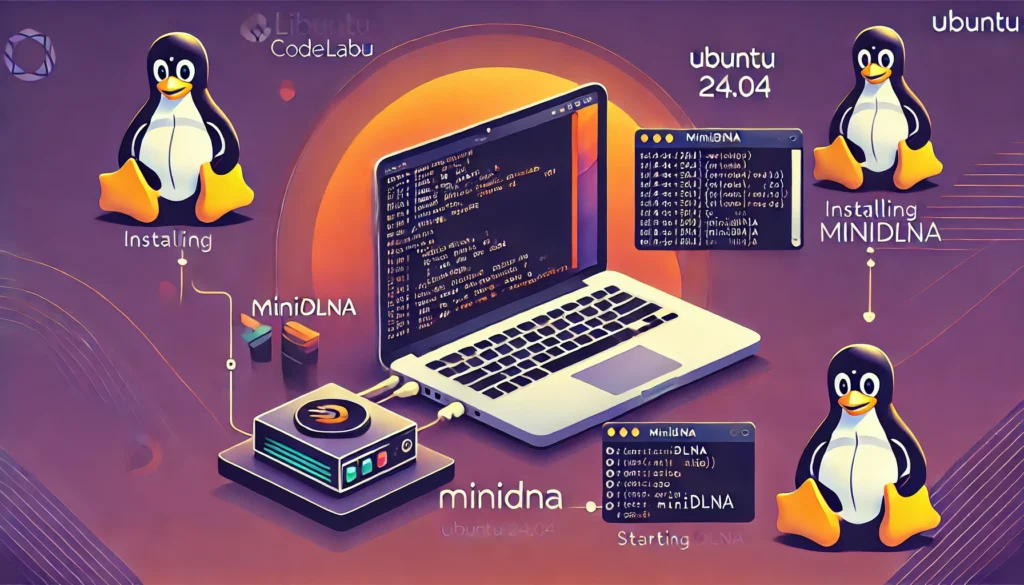How to Install and Configure MiniDLNA on Ubuntu 24.04

Ubuntu 24.04 is a reliable operating system, often used for hosting various services. One popular service is MiniDLNA, a simple and efficient media server. MiniDLNA allows you to stream your media files, such as movies, music, and photos, to devices on your local network. This guide will walk you through the process of installing and configuring MiniDLNA on Ubuntu 24.04.
1. Introduction to MiniDLNA
MiniDLNA, also known as ReadyMedia, is a lightweight DLNA/UPnP media server. It’s designed to be simple and easy to configure, making it ideal for home networks. Once installed, it can serve your media files to any DLNA-compliant device, such as smart TVs, gaming consoles, or media players.
2. Prerequisites
Before we start, make sure you have:
- Ubuntu 24.04 installed on your system.
- Root or sudo access to the terminal.
- Media files (music, videos, photos) stored on your Ubuntu machine.
3. Updating the System
Start by updating your system to ensure all packages are current. Open the terminal and run the following commands:
sudo apt update sudo apt upgrade
This will update your package lists and install the latest versions of your installed packages.
4. Installing MiniDLNA
Ubuntu’s default repositories include the MiniDLNA package, so installing it is straightforward. Use the following command to install MiniDLNA:
sudo apt install minidlna
After running this command, MiniDLNA will be downloaded and installed on your system.
5. Configuring MiniDLNA
The next step is configuring MiniDLNA to recognize your media files and serve them to your devices.
5.1. Accessing the Configuration File
The MiniDLNA configuration file is located at /etc/minidlna.conf. You’ll need to edit this file to specify the locations of your media files and adjust other settings.
Open the configuration file using a text editor like nano:
sudo nano /etc/minidlna.conf
5.2. Specifying Media Directories
In the configuration file, locate the lines that start with media_dir=. You can specify different types of media (audio, video, pictures) by prefixing the directory path with A, V, or P. For example:
media_dir=A,/path/to/music media_dir=V,/path/to/videos media_dir=P,/path/to/pictures
Replace /path/to/music, /path/to/videos, and /path/to/pictures with the actual paths to your media directories.
5.3. Setting the Friendly Name
You can also set a friendly name for your MiniDLNA server, which will be displayed on your devices. Find the friendly_name option in the configuration file and set it as follows:
friendly_name=MyMediaServer
Replace MyMediaServer with the name you want your DLNA server to have.
5.4. Setting the Network Interface
If your Ubuntu machine has multiple network interfaces, you can specify which one MiniDLNA should use. Find the network_interface option and set it like this:
network_interface=eth0
Replace eth0 with the name of your network interface. You can check your interfaces using the command ip a.
5.5. Enabling Inotify
Inotify allows MiniDLNA to detect changes in your media directories automatically. Ensure this feature is enabled by setting:
inotify=yes
5.6. Configuring Other Options
There are several other options you can configure, such as the database path, log level, and more. However, the above settings are the most crucial for a basic setup.
6. Starting and Enabling MiniDLNA
Once you’ve configured MiniDLNA, you need to start the service and enable it to run on boot.
Start the MiniDLNA service with:
sudo systemctl start minidlna
To enable MiniDLNA to start automatically on boot, use:
sudo systemctl enable minidlna
7. Scanning Media Files
After starting the service, MiniDLNA will scan your media directories and build its database. You can force a scan manually by running:
sudo minidlnad -R
This command rebuilds the entire media database. The process might take a few minutes, depending on the size of your media library.
8. Checking the Status of MiniDLNA
You can check the status of the MiniDLNA service to ensure it’s running correctly:
sudo systemctl status minidlna
This command provides information on whether MiniDLNA is active and any potential issues.
9. Accessing MiniDLNA from Devices
Now that MiniDLNA is running, you can access your media from any DLNA-compliant device on your network. Simply open the media player on your device and look for the server name you specified. Your media files should be available for streaming.
10. Troubleshooting
If you encounter issues, here are some common troubleshooting steps:
- Firewall issues: Ensure that the firewall on your Ubuntu machine is not blocking DLNA traffic. You can allow DLNA traffic by running:
sudo ufw allow 1900/udp sudo ufw allow 8200/tcp - Permission problems: Verify that MiniDLNA has permission to access your media directories. You can adjust the permissions by running:
sudo chown -R minidlna:minidlna /path/to/media - Incorrect configuration: Double-check your configuration file for typos or incorrect paths. You can restart the service after making changes by using:
sudo systemctl restart minidlna
Conclusion
MiniDLNA is a powerful yet simple tool for streaming media files across your network. By following this guide, you’ve installed and configured MiniDLNA on Ubuntu 24.04. You can now enjoy your media on any compatible device within your network. With its easy setup and minimal maintenance, MiniDLNA is an excellent choice for home media streaming.
Thank you for reading the article! If you found the information useful, you can donate using the buttons below:
Donate ☕️ with PayPalDonate 💳 with Revolut






















